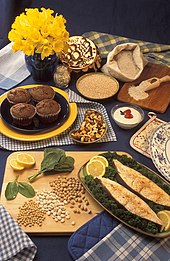Types of nutrient
|
Main article: Nutrition |

Macronutrients are defined in several different ways.[4]
- The chemical elements humans consume in the largest quantities are carbon, hydrogen, nitrogen, oxygen, phosphorus, and sulphur, or CHNOPS.
- The classes of chemical compounds humans consume in the largest quantities and which provide bulk energy are carbohydrates, proteins, and fats. Water and atmospheric oxygen also must be consumed in large quantities, but are not always considered "food" or "nutrients".
- Calcium, salt (sodium and chloride), magnesium, and potassium (along with phosphorus and sulfur) are sometimes added to the list of macronutrients because they are required in large quantities compared to other vitamins and minerals. They are sometimes referred to as the macrominerals.
Substances that provide energy
- Carbohydrates are compounds made up of types of sugars. Carbohydrates are classified by their number of sugar units: monosaccharides (such as glucose and fructose), disaccharides (such as sucrose and lactose), oligosaccharides, and polysaccharides (such as starch, glycogen, and cellulose).
- Proteins are organic compounds that consist of amino acids joined by peptide bonds. The body cannot manufacture some of the amino acids (termed essential amino acids); the diet must supply them. Through digestion, proteins are broken down by proteases back into free amino acids.
- Fats consist of a glycerin molecule with three fatty acids attached. Fatty acids are unbranched hydrocarbon chains connected by single bonds alone (saturated fatty acids) or by both double and single bonds (unsaturated fatty acids). Fats are needed for construction and maintenance of cell membranes, to maintain stable body temperature, and to sustain health of skin and hair. Because the body does not manufacture certain fatty acids (termed essential fatty acids), they must be obtained via the diet.
- Ethanol supplies calories. For spirits (vodka, gin, rum, etc.) a standard serving in the United States is 1.5 fluid ounces, which at 40% ethanol (80 proof) would be 14 grams and 98 calories. At 50% alcohol, 17.5 grams and 122.5 calories. Wine and beer contain a similar range of ethanol for servings of 5 ounces and 12 ounces, respectively, but these beverages also contain non-ethanol calories. A 5-ounce serving of wine contains 100 to 130 calories. A 12-ounce serving of beer contains 95 to 200 calories.[citation needed] According to the U.S. Department of Agriculture, based on NHANES 2013-2014 surveys, women ages 20 and up consume on average 6.8 grams of alcohol per day and men consume on average 15.5 grams per day.[5] Ignoring the non-alcohol contribution of those beverages, the average ethanol calorie contributions are 48 and 108 cal/day.[citation needed] Alcoholic beverages are considered empty calorie foods because, other than calories, they contribute no essential nutrients.
Fat has an energy content of 9 kcal/g (~37.7 kJ/g); proteins and carbohydrates 4 kcal/g (~16.7 kJ/g); ethanol 7 kcal/g (~29.3 kJ/g).[citation needed]
Substances that support metabolism
- Dietary minerals are generally trace elements, salts, or ions such as copper and iron. Some of these minerals are essential to human metabolism.
- Vitamins are organic compounds essential to the body. They usually act as coenzymes or cofactors for various proteins in the body.
- Water is an essential nutrient and is the solvent in which all the chemical reactions of life take place.
|
Main articles: Plant nutrition and Fertilizer |

Plants absorb nutrients from the soil or the atmosphere, or from water (mainly aquatic plants). An exception are the carnivorous plants, which externally digest nutrients from animals before ingesting them.[6]
The chemical elements consumed in the greatest quantities by plants are carbon, hydrogen, and oxygen. These are present in the environment in the form of water and carbon dioxide; energy is provided by sunlight.[7] Nitrogen, phosphorus, and sulfur are also needed in relatively large quantities. Together, the "Big Six" are the elemental macronutrients for all organisms,[8] often represented by the acronym CHNOPS.[9] Usually they are sourced from inorganic (e.g. carbon dioxide, water, nitrate, phosphate, sulfate) or organic (e.g. carbohydrates, lipids, proteins) compounds, although elemental diatomic molecules of nitrogen and (especially) oxygen are often used.
Other chemical elements are also necessary to carry out various life processes and build structures; see fertilizer and micronutrient for more information.

Some of these are considered micronutrients in certain organisms. The mnemonic C. HOPKN'S CaFe Mg (to be used as C. Hopkins coffee mug) is used by some students to remember the list as: carbon, hydrogen, oxygen, phosphorus, potassium, nitrogen, sulfur, calcium, iron, and magnesium. Silicon, chloride, sodium, copper, zinc, and molybdenum are sometimes also included, but are in other cases considered micronutrients.[10]